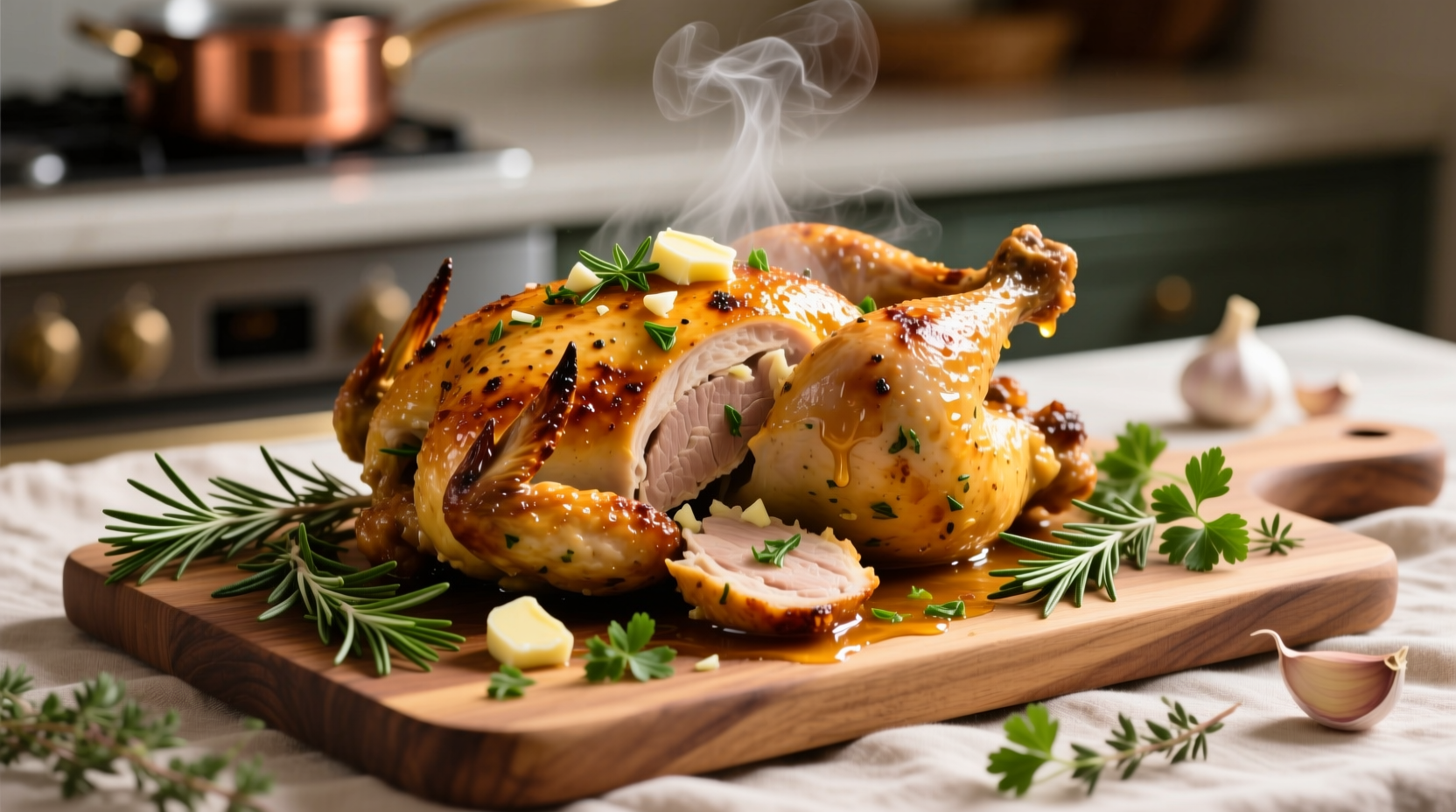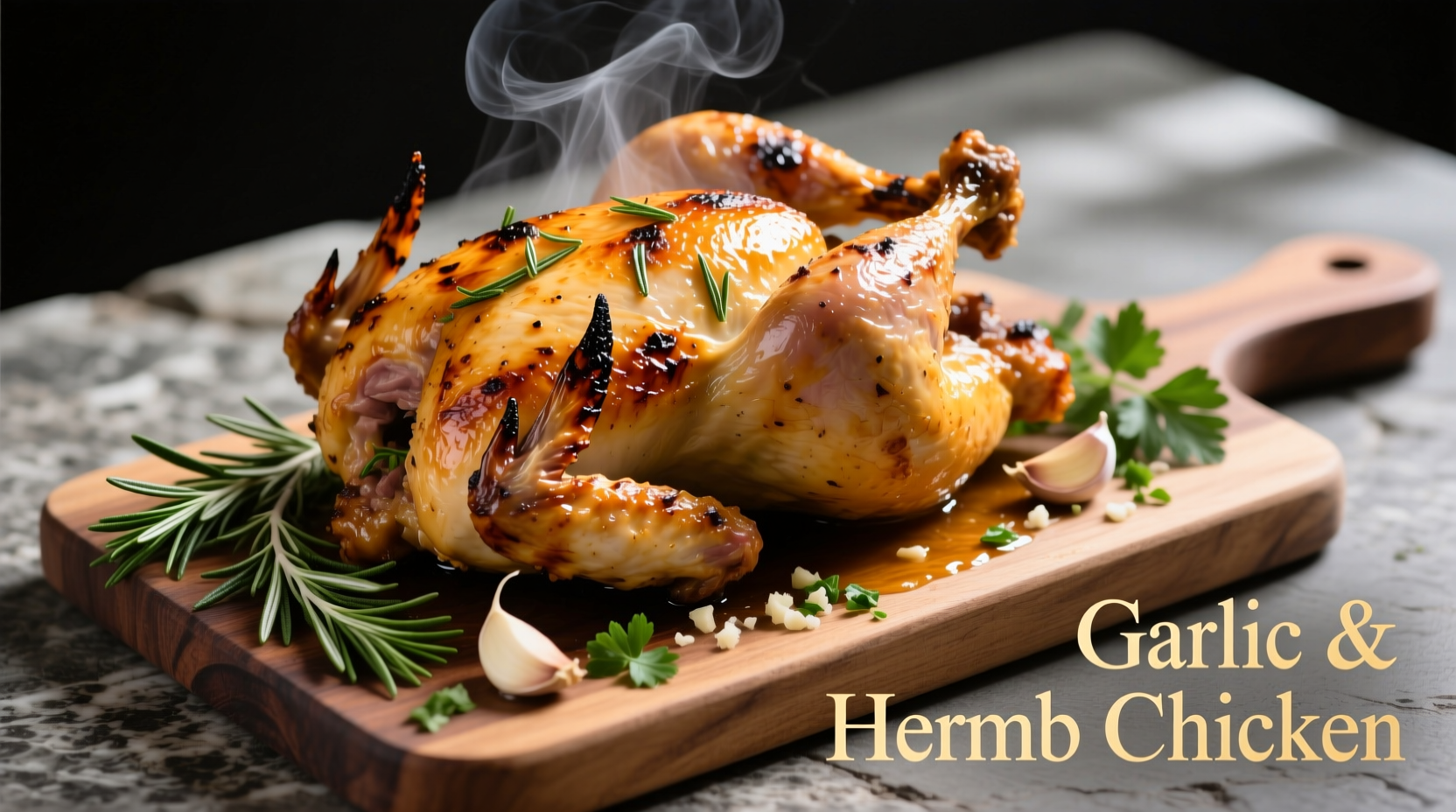Perfect garlic and herb chicken requires bone-in, skin-on chicken pieces seasoned with fresh herbs, garlic, lemon, and olive oil, roasted at 400°F (204°C) for 35-45 minutes until internal temperature reaches 165°F (74°C). This foolproof method delivers crispy skin, juicy meat, and aromatic flavors that elevate a simple weeknight dinner into something extraordinary.
Nothing transforms ordinary chicken into an extraordinary meal quite like the aromatic combination of fresh garlic and herbs. Whether you're preparing a quick weeknight dinner or hosting weekend guests, mastering garlic and herb chicken unlocks a world of culinary possibilities. This versatile preparation method works equally well with chicken breasts, thighs, or a whole bird, adapting seamlessly to various cooking techniques from roasting to grilling. Our tested recipe delivers consistently crispy skin and succulent meat while maximizing flavor absorption through proper seasoning techniques and temperature control.
Why This Garlic and Herb Chicken Method Works
The magic happens through three critical elements: proper seasoning distribution, optimal cooking temperature, and strategic resting time. Unlike many recipes that simply sprinkle herbs on top, our approach incorporates seasoning beneath the skin and in the cavity for flavor penetration at multiple levels. The high roasting temperature (400°F) creates the perfect Maillard reaction for golden-brown skin while keeping the interior moist. Understanding these principles transforms your cooking from hit-or-miss to consistently impressive results.
Essential Ingredients and Their Roles
Quality ingredients make the difference between ordinary and exceptional garlic herb chicken. While substitutions exist, understanding each component's purpose helps maintain integrity when adapting the recipe.
| Ingredient | Primary Function | Key Substitutes |
|---|---|---|
| Fresh rosemary | Earthy backbone flavor | Thyme (milder) or oregano (Mediterranean twist) |
| Fresh thyme | Floral complexity | Marjoram (sweeter) or savory (peppery) |
| Garlic cloves | Aromatic foundation | Shallots (milder) or leeks (sweeter) |
| Lemon zest | Acid balance | Lime zest (tangier) or orange zest (sweeter) |
Step-by-Step Preparation Guide
Pre-Cooking Preparation (15 minutes)
Dry the chicken skin thoroughly with paper towels—this critical step ensures proper browning. Gently loosen the skin from the meat using your fingers, being careful not to tear it. This creates pockets for seasoning directly against the meat. Combine 4 minced garlic cloves, 2 tablespoons chopped fresh rosemary, 1 tablespoon chopped fresh thyme, 1 teaspoon lemon zest, and 2 tablespoons olive oil to form a paste. Rub half this mixture beneath the skin and the remainder over the top.
Cooking Process (40 minutes)
Preheat your oven to 400°F (204°C) with rack positioned in the center. Place chicken skin-side up in an oven-safe skillet or roasting pan. Roast undisturbed for 35-45 minutes (depending on piece size) until the internal temperature reaches 165°F (74°C) at the thickest part, measured with an instant-read thermometer inserted between meat and bone. The USDA Food Safety and Inspection Service confirms this temperature destroys harmful bacteria while preserving moisture (source).

Resting and Serving (10 minutes)
Transfer chicken to a cutting board and tent loosely with foil. Resting for 10 minutes allows juices to redistribute throughout the meat—skipping this step causes precious juices to escape when cutting. While resting, prepare a quick pan sauce by deglazing the roasting pan with 1/2 cup chicken broth over medium heat, scraping up browned bits. Simmer until slightly reduced, then stir in 1 tablespoon butter and remaining fresh herbs.
Avoiding Common Garlic Herb Chicken Mistakes
Even experienced cooks encounter pitfalls with this seemingly simple dish. Understanding these challenges prevents disappointment:
- Garlic burning: Minced garlic burns at 325°F—always combine with oil or butter before applying to chicken
- Soggy skin: Failure to pat skin dry before seasoning prevents proper crisping
- Dry meat: Overcooking by just 5 minutes significantly reduces moisture retention
- Uneven seasoning: Not seasoning beneath the skin leaves meat bland despite flavorful exterior
Historical Context of Garlic in European Chicken Dishes
Garlic's journey in European cuisine reveals why it pairs so perfectly with poultry. Originally cultivated in Central Asia, garlic spread through trade routes to Mediterranean Europe around 3000 BCE. By the Roman era, it became a staple seasoning for meats, with Apicius' 1st-century cookbook De Re Coquinaria featuring multiple garlic-based poultry preparations. During the Middle Ages, monastic gardens preserved garlic cultivation knowledge while European explorers later introduced it to the Americas. This historical integration explains why garlic complements traditional European herbs like rosemary and thyme in chicken dishes—they've evolved together in culinary practice for millennia.
Perfect Pairings for Garlic Herb Chicken
Complete your meal with sides that complement rather than compete with the main dish's flavor profile:
- Roasted vegetables: Fingerling potatoes, asparagus, or cherry tomatoes tossed with olive oil and herbs
- Grain accompaniments: Lemon-herb couscous or wild rice pilaf with toasted almonds
- Salad options: Arugula with shaved Parmesan and lemon vinaigrette
- Sauces: Chimichurri for Latin-inspired variation or tzatziki for Mediterranean twist
Storage and Reheating Guidelines
Proper storage maintains food safety while preserving quality. Cool cooked chicken within 2 hours of cooking, then store in airtight containers for up to 3-4 days in the refrigerator. For best reheating results:
- Oven method: 325°F (163°C) for 15-20 minutes covered with foil, then 5 minutes uncovered
- Air fryer: 300°F (149°C) for 8-10 minutes for crispy skin restoration
- Avoid microwave: Creates uneven heating and rubbery texture
Variations for Dietary Preferences
Adapt this classic preparation to accommodate various dietary needs without sacrificing flavor:
- Gluten-free: Naturally compliant—ensure broth and seasonings contain no hidden gluten
- Dairy-free: Substitute olive oil for butter in pan sauce
- Keto-friendly: Serve with roasted vegetables instead of starches
- Low-sodium: Use fresh herbs generously and reduce added salt by 50%
Frequently Asked Questions
Can I use dried herbs instead of fresh in garlic herb chicken? While fresh herbs provide superior flavor, you can substitute dried herbs at a 3:1 ratio (1 teaspoon dried for 1 tablespoon fresh). Add dried herbs earlier in cooking to allow time for rehydration and flavor development.
Why does my garlic herb chicken skin stick to the pan? Skin sticks when the pan isn't sufficiently preheated or when moving chicken too soon. Allow chicken to sear undisturbed for 5 minutes before attempting to turn or transfer to oven.
How can I make garlic herb chicken without an oven? Use a cast-iron skillet on the stovetop: sear skin-side down for 8 minutes, flip, then cover and cook on low for 20-25 minutes until reaching 165°F internally.
What's the best way to prevent garlic from burning? Always combine minced garlic with oil or butter before applying to chicken. For extended cooking times, add half the garlic at the beginning and the remainder during the last 10 minutes of cooking.
Can I prepare garlic herb chicken ahead of time? Yes—season and refrigerate up to 24 hours before cooking. For best results, bring to room temperature for 30 minutes before roasting to ensure even cooking.











 浙公网安备
33010002000092号
浙公网安备
33010002000092号 浙B2-20120091-4
浙B2-20120091-4